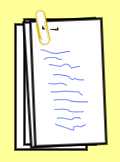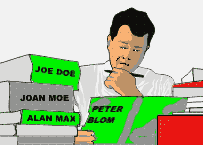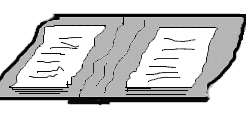Home Search Level 0 Level 1 Level 2 Level 3 Level 4 Level 4Pro Level 5 C/Sing Solo
| Tech terms | Scales | Axioms | Drills | Checksheets | Processes | Prep. lists | C/S terms | C/S tool | Grades | Cramm | Points | KTW | Online |
|
Home Search Level 0 Level 1 Level 2 Level 3 Level 4 Level 4Pro Level 5 C/Sing Solo |
|
|
| Tech terms | Scales | Axioms | Drills | Checksheets | Processes | Prep. lists | C/S terms | C/S tool | Grades | Cramm | Points | KTW | Online | |
PC Folders and Auditors Admin

Each pc needs to have an auditing folder. A folder is large file folder (A4 size or legal paper size, usually slightly bigger). It's made out of light cardboard as a normal filing folder.
The pc's name is marked clearly on the
outside with a fat felt pen. The folder is also given a number. The pc's first
folder is #1. When that is getting too big to handle ( about 7 cm or 3"
thick) a folder #2 is made up, etc.
The date the folder was started and ended should also be marked on the outside,
as well as the pc's case level ("Grade 2" on picture).
 |
The folder is a simple card
board |
It is practical to have a big rubber band around it to keep the papers inside from falling out.
The folder contains all the data related to the
pc's auditing and case. By keeping a good record you will always know where the
pc is at, what processes have been run and, if the pc later should have troubles
with earlier auditing or have unhandled conditions, you can always go back and
see exactly what was done. You can see if any errors were made and repair them.
That done, you can write a new program to handle his complaint.
The pc folder contains a number of reports that
each gives a certain aspect of the activity. Each session report can
consist of 4 or more such forms and reports. One complete session report
is piled on top of the previous one. It is briefly recorded in the Folder Summary.
Here are the different reports the
complete session report can contain.
 |
The session report is stapled and paper-clipped together. It includes: 1) Works sheets 2) Auditor Report Form 3) Suggested C/S 4) Exam Report 5) Any lists used |
The Session Report
is stapled and paper-clipped together after
session. There are: (1) the work sheets, (2) Auditor Report Form, (3) Exam
Report, (4) Suggested C/S form, (5) any special sheets and lists used in that
session.
 |
Auditor keeps a |
The worksheets (W/S)
The worksheets contain the notes made during session. The auditor writes
a complete continuous record of the session from beginning to end, page after
page, as the session progresses.
A worksheet is usually A4 or letter size (8" x 11") but also legal size (8" x 13") can be used. You write on both sides and number the pages at the top. The numbers are so the auditor can refer to actions and phenomena. "Please look at page 15. There was a Rock Slam." Page numbers can save a lot of time. Further, it makes it possible to get the session report sorted out in order before stapling it together after session.
The worksheet is written in two columns. The auditor writes in the left-hand column and then uses the right-hand column. The most important parts of the session W/S are:
a. when the TA goes up (on what?)
b. when the TA goes down (on what?)
c. when an F/N occurs (on what, any cognition?)
d. when VGIs occur (on what?)
e. if BIs (Bad Indicators) occur (on what?)
f. how the process ran (also commands usually represented by numbers and abbreviations).
The auditor writes TA and time regularly during the session. When a process has reached EP, you write the pc's cognition, circle the F/N and whether or not it was indicated; note the pc's indicators, the time and TA.
| PC: John Doe (1) Date: xx/xx/xx | |
|
Food? |
Clear Commands: Words: Fly (V) F/N ind Birds (V) F/N ind Do (V) F/N ind C.C. "Do Birds Fly?" F O.K. T.I.T.P. Time: 3:10 TA: 2.7 (1) Yes, in air (1) Yes, over land (1) Yes, over ocean Orig: I realize most birds fly!! (COG). TA: 2.7 { Time: 3:20 2.5 (F/N) VGI IND Say or Ask? Feels great! (F/N) VGI IND Time: 3:22 E.O.S TA: 2.4 |
| Worksheet. You note TA and Time. The pc's answers in very short form and short hand for auditor's actions. T.I.T.S. = This is the session ARC x = ARC break (and the Assessment ARCU and CDEINR below). (F/N) IND = F/N circled and indicated to pc. BIs/VGIs = Bad Indicators/Very good indicators. In next column: Clearing the words and a command. (1) is for each time command is given. T.I.T.P. = This is the process. Orig/COG = Origination/Cognition E.O.S. = End of Session. You would usually use a blank sheet of paper and make a fold down the middle to keep the columns. |
|
When running a two-way communication process, it is important that all items (terminals, statements, etc.) that read are marked on the worksheets: SF, F, LF, LFBD. All reading items are circled in green after the session.
Rock Slam items, ethics situations, service facsimiles and evil purposes are marked after the session by cycling them on the worksheet with a red pen.
Auditors need to develop a system of shorthand for what is being done, so that session speed can be kept up regardless of keeping the report up. For example, the process:
1. Recall a change
2. Recall a no change
3. Recall a failed change
is run as a bracket (1,2,3,1,2,3, etc.). The first command can be abbreviated to 1, the second to 2 and the third to 3. The worksheet for this would look like:
(time) 12:32 (TA) 2.8
Clear words:
change (F/N) vgi - ind
'no' (F/N) vgi -ind
recall v (F/N) vgi - ind
(Note that each word of the command is cleared before clearing the command as whole.)
1. cleared
2. cleared
3. cleared(time) 12:49 (TA) 2.6
1. Mother went on holiday
2. at school
3. didn't sell bike
1. moved to new house
2. etc.
 |
pc: N.N.
Date xx/xx/xx VERY WELL DONE- Mr. C/S
C/S OK. Mr. C/S. |
|
C/S, the Case Supervisor. He |
C/S, The Case Supervisor's |
After the session the auditor writes the commands in full on the Auditor's Report Form with the numbers so the Case Supervisor (C/S) can understand what went on. Different systems of abbreviation can be used by the auditor, but the worksheets must communicate to the C/S what actions were taken during the session.
Worksheets should be readable. They are never copied. The auditor always needs to read over his worksheets before turning in the folder to the case supervisor. Any words or letters missing should be clarified. Use a red pen and block print.
Example:
TOTALLY
want to get@#%&^well
This can easily be overdone. At the most, worksheets should need one or two corrections per page. If this causes the auditor problems he should learn how to write rapidly and legibly. He can drill it making notes of a radio program, a recording or drill it with a twin.
It is forbidden to give a session without making an auditor's report (meaning, actual worksheets written at that time) or to copy the original worksheets after the session and turn in a copy instead of the real reports.
When giving Assists, using only contact assists or touch assists, the report should be written right after the Assist and be included in the pc folder.
Any time a C/S sees long 'stenographic' report in the auditor's worksheets he knows the pc did not have an auditor there to run the session. An auditor, who is writing down every word the pc says (like a stenographer) will have out TRs and bad session control. No auditor can write fast enough to do that and it isn't necessary either. It's more important to observe the pc, maintain session control and keep his TRs smooth. The session is for the pc - not the report. On the worksheets you note the technical actions taken by the auditor, the pc responses, the time and TA. You have to develop a shorthand system to keep up speed. The C/S expects a short summary of the incident or what the pc said. He needs sufficient data to know what sort of incident was being run and if it is run correctly.
An auditor who just sits and lets the pc go on and on running things on his own will seldom get results. The auditor has to control the session. The auditor should know the session performance is more important than the report. He will learn never to hold the pc up while writing as the pc will drift out of session.
A stenographer is not an auditor. An auditor controls the session, the pc's Bank and mental pictures. He gets results to the degree he has excellent TRs and session control.
The Auditor Report Form (ARF)
An Auditor's Report Form is made out
immediately after each
session. It is a one page summary of actions that were taken in the session. It
is a cover page put on top of the works sheets before they are stapled together:
|
Auditor Report Form |
|||
|
PC:_______________
Date:__________ |
|||
|
Action |
Time |
TA |
Result |
This is the Session Rud: ARCx? 1) Do Birds Fly Say & Ask? End of Session |
11:33 11.40 11.42 12.02 12.10 |
3.1 2.7 2.8
2.6
|
Pc: Looks content F/N VGI Ind Clear Command |
|
Trim Check: 1.95 |
|||
Each ARF should at the top have:
1. Preclear's name (first/last) and Grade of release.
2. Auditor's name (full name).
3. Date.
4. Number of hours pc bought (if applicable).
5. Length of session (minus breaks (example: 3 h 05 m). This is "hours in the chair."
6. How many hours used of 'hours bought'
7. Total TA action for the session. This is an indicator of case progress and is important.The body of the form is filled in with the following information:
8. Time of start and end of session.
9. Condition of pc.
10. TA and sensitivity setting at beginning and end of session.
11. Rudiments.
12. What process was run. Here you list the exact commands. If you had the commands printed out or written out, you may attach that instead. But it has to be clear, so the worksheets' shorthand can be understood.
13. Time, TA and sensitivity at start and end of process.
14. Whether a process is taken to EP or not.
15. Any F/Ns or EP's
16. Any rock slam (R/S) items or evil purposes noted in the right hand column in red.
17. TA range.At the bottom of the form the trim check is written. As: Trim check = 1.85
|
Exam Report Pc:
___________
Date: _______ Needle: __________
F/N Indicated? ____ |
The Exam Report is made right |
The Examiner's Report (Exam)
An Exam report is a report not made by the
auditor. It is made by an independent Examiner. This is done after
a session or when the pc goes on his own volition because he wants to make a
statement about a change (a win, a problem or illness).
There may not always be an Examiner available in case of an individual practitioner. In a small office another auditor may act as Examiner.
The exam report contains the Meter details, pc's indicators and pc's statement. The Examiner's form should contain the following information:
- If it is "After Session," or "Volunteered" or "Medical".
- The date is noted, e.g., 4 July, 20xx. Time is noted, e.g., 19:22 hrs. The date and time are important as it has to be filed correctly in the pc's folder later.Pc's name is clearly printed.
- "Pc's statement"--Write down exactly what pc says. Note also what reads, BDs and where his indicators change and vary, tone in which statements are made and so on.
- "TA position and any BD"--note TA position at start of exam and TA position at end if different.
- Any obvious manifestation it would be helpful for the C/S to know is noted.
- Examples: BIs pc crying; OK. Pc frowning. VVGIs, pc radiant, skin tone very pink.
- "Needle behavior"--This is important. Different needles mean different things, i.e., R/S, DN (Dirty needle), RISE, F/N etc.
- If F/Ns note the size. Small F/N = 1" to 2" (at sensitivity 8).
- Normal F/N = 2" to 3". Wide F/N = 3" to 4". Dial F/N = Floating right across the dial. Floating TA = Can't get the needle to stay on dial.
- On Floating TA give range if possible, like F/N TA = 2.5 - 2.3.
- Size of F/Ns is important. A wide FN at session end to a small F/N at Examiner, would indicate something is wrong.
- "F/N indicated to pc"--If so, write YES, if not, skip it.
- Signature of Examiner.
Sensitivity: All exams are done at sensitivity 8.
|
|
A red tag should be clearly marked |
A RED TAG EXAM Report
The report is marked with a red tag if the Examiner sees
any one of the following manifestations in a pc after a session:
1. Non-optimum TA position (above 3, below 2) - excluding False TA.
2. Non-optimum needle (ARC break needle, stage 4, rock slam, stuck, still or dirty)
3. Bad indicators
4. Non-optimum statement from pc, critical, hostile, sad, etc.
When a red tag exam occurs the Examiner marks Exam
report with
a red marker and paper clips a RED CARD on the outside of the pc folder (if
folder available). Red tag folders must get handled on a rush priority
basis.
The pc needs to be taken into session within 24 hours for a 'repair' session.
The exam report form is put in the folder on top of the summary report. Volunteered exam report forms are put in the folder at the appropriate date.
|
pc: N.N.
Date xx/xx/xx VERY WELL DONE- Mr. C/S
C/S OK. Mr. C/S. |
|
|
The Case Supervisor's written |
Even when working by himself the |
The Auditors Suggested C/S
The auditor's C/S is a sheet on which the auditor writes
the C/S instructions for the next session. He will usually follow the program and simply suggest the
next steps from there. Here is a detailed example:
|
C/S FORM
Auditor's Name (red)____ Session grade (left blank for the C/S to determine) Auditor's comment (red) he briefly states how it is going
and The next C/S (Blue) 1. Fly a rudiment to FN VGI's. 2. Run process # 6 from the Grade 0 sheet. 3. Continue with Grade 0 processes 4. Run Havingness if needed. Auditor signature (red)
|
The suggested C/S is put on top of a completed session report, so it is the first thing the case supervisor sees, when opening the folder. The case supervisor grades the session turned in and approves or changes the C/S for the auditor to do in the next session.
|
Date: _________
|
Various lists and items are
|
You would put pc's name and the date on it and write items under each other. You would leave enough room to the right of the items to be able to draw several columns.
Next time you read the list to the pc 'to find longest read' you will mark the read of each item in one column. You mark the item you take up. You would attach this sheet to the back of your session report with a paper clip so it easily can be taken out for the next Assessment.
There are also several different sheets stapled to the inside of the folder, front and back, in a folder "made by the book". Those give you an Index and quick overview of the content of the sessions done. When you get good at it, it is quick to keep it all up and in the long run it saves all involved time and ensures better results.
 |
Inside the folder - front and back - |
Folder Summary (F/S)
The folder summary is written on sheets stapled to the
inside of the front cover. It is brief summary of the actions taken on a pc in
the right order. It gives a 'Table of Content' of the folder.
It contains the following data:
1. ADMIN. Session date, length of time of session and admin time. When a new folder is started. The total time of a series of auditing sessions. When an OCA test (personality test) is taken. When a Folder Error Summary (FES) was done.
2. PROCESS DETAILS. What was run and how it ran. Mark beside each action taken 'to EP' or 'Not to EP'. Whether UNFLAT, O/R, or whatever.If an item or terminal R/Ses in session, it is noted in red on the F/S with the page number and circled. Also an evil purpose expressed in a session is marked in red with the date and circled.
3. EXAM REPORT. At the end of session details, mark Examiner report results. EX: F/N if F/N at the Examiner, or BER (red) if a Bad Exam Report. If TA was high or low at exam, it should also be noted.
4. ATTESTS. When pc completes an auditing action and attests (usually with the Examiner) it is noted. Date and what was attested. If pc did NOT want to attest, this is noted (in red).
5. MEDICAL DATA. When pc reports sick. Date and brief statement of illness. And again when pc off medical treatment.
6. ETHICS DATA. Any ethics condition or action. Use blue pen for normal entries. Use red pen to mark any R/Sing item, evil purpose, corrections, Red Tag exams, flubbed attest, medical or ethics actions.
The auditor is responsible for keeping up this F/S after each session and likewise on receipt of a medical report, Red Tag report, etc. It is a standard part of the auditor's session admin. The F/S sheets are divided into four columns.
When a new pc starts auditing and the first folder is made up, a sheet for F/S is stapled inside the front cover. The auditor fills in the F/S as he progresses with the auditing. New sheets are added as needed, the most recent on top. When a new folder is made up all summary sheets are removed from the old folder and placed at the inside cover of the new folder so the complete folder summary of the case is always in the current folder.
|
Folder Summary: |
|||
| 22/5//xx 1h14min Admin:15min |
X process to EP Ex: F/N |
||
| 23/5/xx 1h22min Admin:15min |
Y Process to EP Ex: BER |
||
| 23/5/xx 30min Admin:10min |
L1C m3 to F/N VGI Y process flattened to EP. Ex: F/N |
||
| 24/5/xx | PC Attest: XY RD | ||
So the C/S supervises the auditing and makes sure the pc is winning and progressing. He starts his work by writing a program for the pc.
The program sheet states the pc's name, the date, brief case notes of why the program is being written, and the actions numbered 1, 2, 3, etc., to be done on the pc to bring about a definite result. The C/S prints his name at the bottom.
The program sheets are kept paper clipped on the inside of the front cover, earliest at the bottom and current (latest) on top.
The C/S works at completing the program they are on. As each step of the program is completed it is checked off marked "Done" with the date. When the whole program is done, it is marked "Program Done (Date)." Any flubs made during the program are marked in and repaired. Any program terminated because of new data about the pc should be so marked with the date.
Evil purposes and R/S items are marked on the left-hand edge of the current program in red with the date and W/S page number.
Any Additional Reports
You may find additional reports and sheets. Inside the
back cover should be the Yellow
Sheet, A sheet detailing each correction list or set of commands which have been word cleared. It also lists the pc's current Havingness process and
the type of cans the pc uses. It should be stapled inside to the back of the
folder.
It can seem an awful lot, but with a little bit of experience it takes about 15 minutes to finish up the admin for a 2 hours session.
|
Home Search Level 0 Level 1 Level 2 Level 3 Level 4 Level 4Pro Level 5 C/Sing Solo |
|
|
| Tech terms | Scales | Axioms | Drills | Checksheets | Processes | Prep. lists | C/S terms | C/S tool | Grades | Cramm | Points | KTW | Online | |